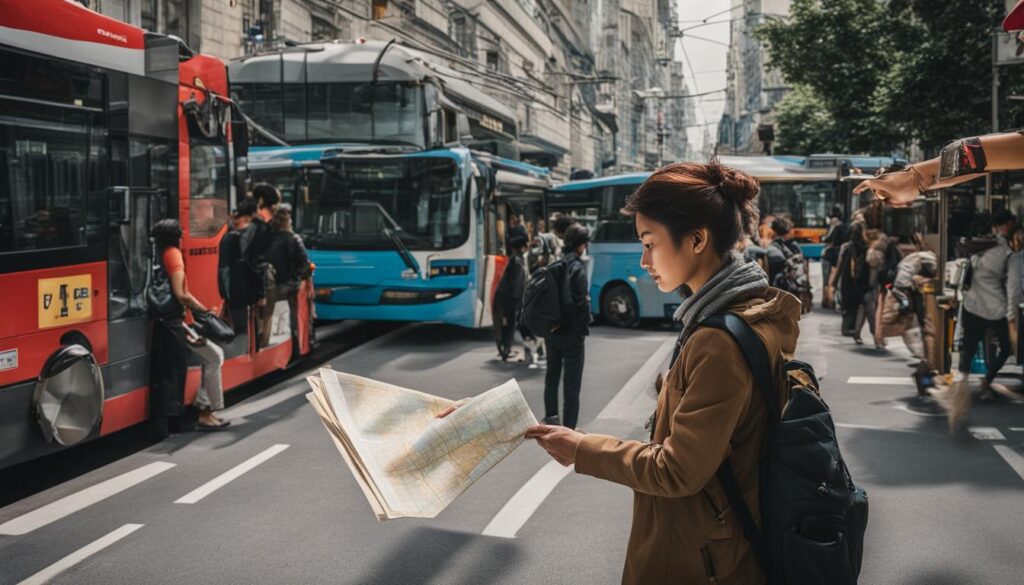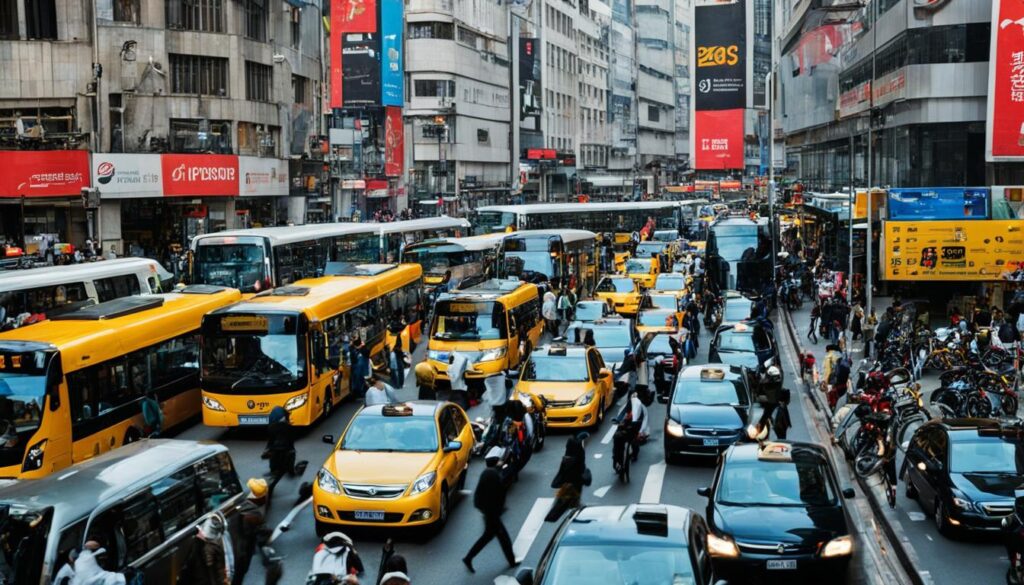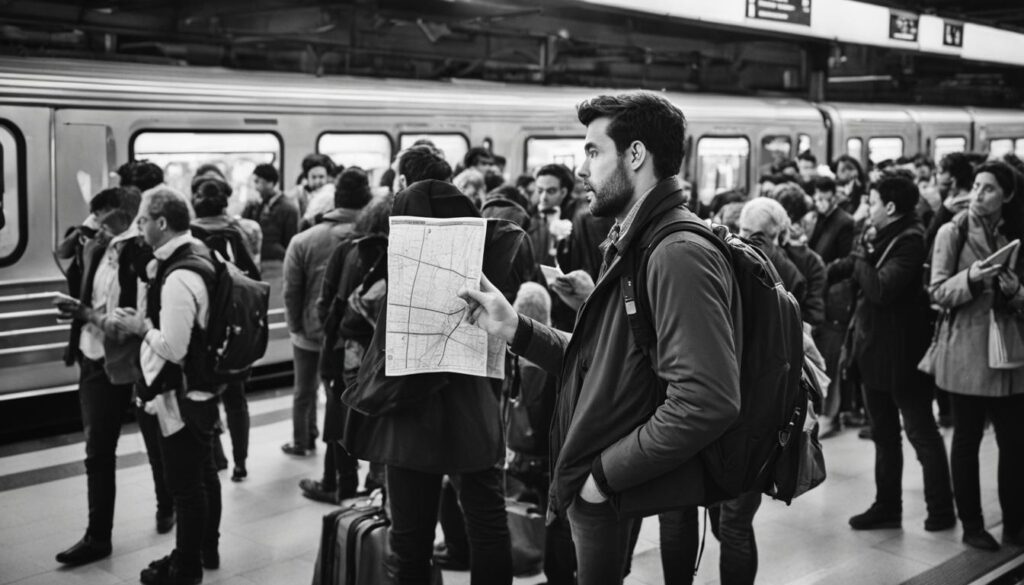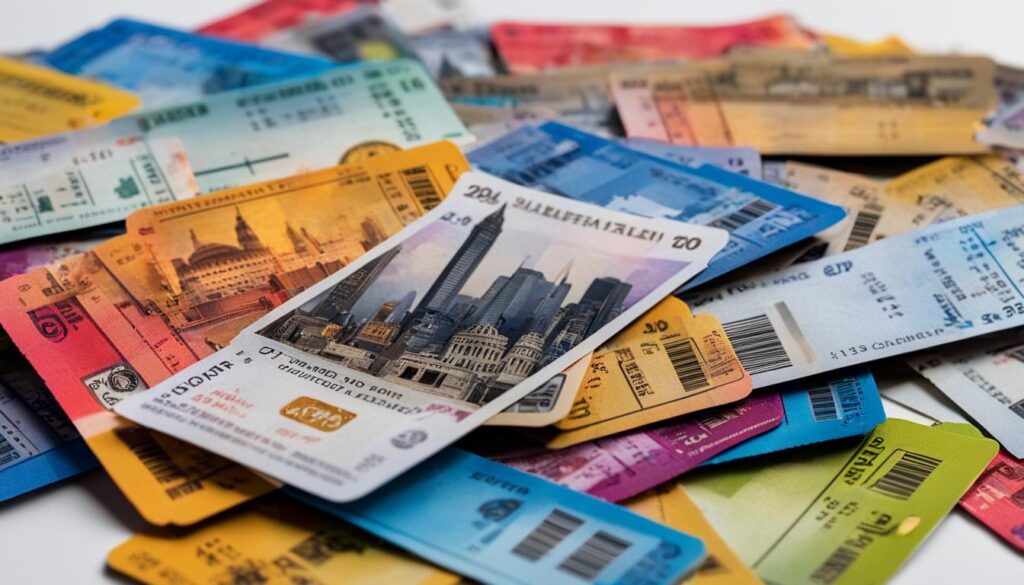Planning to travel abroad? Whether you’re exploring Europe, Asia, or South America, using public transportation can be a convenient and cost-effective way to get around. To help you navigate buses, trains, and other local transportation options, we’ve created this comprehensive using public transportation abroad guide. From transportation options overseas to navigating public transport in foreign countries, this guide covers everything you need to know for travel by bus and train abroad.
Why Use Public Transportation Abroad?
When traveling in a foreign country, it can be tempting to rely on taxis or ride-sharing apps as your primary mode of transportation. However, there are plenty of reasons why using public transportation instead is a smart choice.
- Cost savings: taking the local bus or train is often significantly cheaper than taxi or ride-sharing services, especially for longer journeys.
- Eco-friendliness: using public transportation helps reduce your carbon footprint, making it a more sustainable way to travel.
- Immerse yourself in local culture: traveling by bus or train allows you to experience the flavor of a city like a local rather than just being driven around like a tourist in a taxi.
- Learn the local language: using public transportation gives you more opportunities to hone your language skills and interact with locals.
By using public transportation, you open yourself up to more authentic cultural experiences while saving money and reducing your environmental impact. Don’t be intimidated by local buses and trains – they are often simpler than they seem and can enhance your travel experience in ways you never imagined.
Understanding Transportation Options in Foreign Countries
Traveling to a foreign country means immersing yourself in a new culture, which includes understanding the local transportation system. Every country has its own unique options for public transportation, so it’s essential to be aware of the different methods of travel available to you.
The Most Common Types of Public Transportation Available
Depending on where you are traveling, you may encounter various transportation options. Here are some of the most common types of public transportation you are likely to come across:
| Type of Transportation | Description |
|---|---|
| Buses | Local buses are a popular mode of transportation in many countries, and they offer a cost-effective way to get around. Buses usually have designated stops that are marked on a map or a sign, and you can pay for your ride by using cash or a prepaid bus card. |
| Trains | Trains are a convenient option for long-distance travel, and they are often faster than other modes of transportation. Some trains may require a reservation in advance, while others have an open-seating policy. You can purchase tickets at the train station or online. |
| Metro/Subway Systems | Metro or subway systems are typically found in larger cities and offer an efficient way to get around. They usually have a flat fare for every trip, with discounts for multiple rides or weekly/monthly passes. You can purchase tickets at the station or vending machines. |
| Taxis | Taxis are a convenient option for those who prefer more privacy when traveling. However, they are often more expensive than other modes of transportation and may not be available in some areas. You can hail a taxi on the street or find them parked at designated taxi stands or outside hotels and restaurants. |
It’s important to note that the availability of these transportation options may vary depending on the country and city you are visiting. For example, some cities may have extensive metro systems, while others rely more on buses and taxi services.
When choosing transportation options, consider factors such as cost, speed, convenience, and safety. Researching your options ahead of time can help you make informed decisions and navigate public transportation with ease.
Planning Your Public Transportation Routes
Exploring foreign countries can be an unforgettable experience. And what better way to immerse yourself in local culture than by using public transportation? But before embarking on your journey, it’s crucial to plan your routes and ensure a hassle-free experience.
Firstly, to help navigate public transport in foreign countries, use online journey planners. Sites like TripAdvisor and Rome2Rio can help you determine the best route each step of the way. Below is an informative table on handy journey planning apps:
| App | Features |
|---|---|
| TripAdvisor | One-stop-shop for options on flights, accommodations, and taxis, trains, buses |
| Rome2Rio | Find the cheapest, fastest, and best travel options on Price Alert feature |
| Citymapper | Covers 70 cities worldwide, specific transit options, route suggestions, and disruption alerts |
| Transport for Greater Manchester | City-specific app for getting around Manchester with real-time bus and tram information |
Additionally, understanding timetables and ticketing systems is vital. Most train or bus stations have a digital screen that updates you of the station name, train timings, and boarding platform which is a bonus. Seat61.com gives a comprehensive guide to train travel worldwide. Furthermore, familiarizing yourself with different modes of transportation will improve your traveling experience. Knowing when a bus or train departs, arrives, and the duration between both transports is fundamental.
Tip: Create a list of all the essential information you may need at each station, like bus or train number, boarding location, and arrival time. This makes your journey less stressful and more efficient.
Getting Tickets and Fares
When using public transportation abroad, getting tickets and understanding fare systems can seem overwhelming. However, it is essential to have a basic understanding to avoid wasting time and money. Below we discuss various ticketing options and how to navigate them.
Ticketing Options
The ticket options vary significantly in each country, and it is essential to research the most useful ones for your travel needs before departure. Here are some common options:
- Prepaid Cards: Many cities offer prepaid cards that can be used for multiple trips. These are usually more cost-effective than individual ticket purchases.
- Single-Ride Tickets: These tickets are usually available at vending machines or ticket counters. They are suitable for a one-time journey, and individual ticket prices are higher.
- Day Passes: Perfect for those intending to use public transportation frequently. Day passes usually provide unlimited access to an area’s buses and trains for a 24-hour period.
It is essential to understand which option suits your needs before purchasing. In addition, keep track of any time or zone restrictions, particularly when using single-ride tickets.
Fare Zones
In many countries, fare systems are based on zones. Deciphering which zone you are in can be confusing, but it is essential to avoiding fines or extra charges. You may need to navigate through a complex map or list of the zones to identify the correct fare. Always check with transportation information booths or officials when in doubt.
Common Pitfalls to Avoid
Using public transportation abroad can be daunting, and many travelers make common mistakes when purchasing tickets. Keep these pitfalls in mind:
- Not purchasing the right ticket for the type of transport or journey
- Not validating your ticket on buses and trains where validation is required
- Not having the correct change or currency to purchase tickets at vending machines or ticket counters
By keeping these pitfalls in mind, you can save time, money, and unwanted stress.
Navigating Local Buses
Buses are a convenient and affordable mode of transportation in many countries. However, navigating local bus systems can be a challenge, especially if you’re unfamiliar with the language or area. Here are some useful tips to help you travel by bus abroad.
Understanding Bus Routes
Before boarding a bus, make sure you understand the route it takes. Most bus routes have a specific starting point and destination and may make stops along the way. Look for bus route maps or ask for directions at a local transit office or information center. Alternatively, you can use public transportation apps to find the route and schedules for your destination.
Locating Bus Stops
Bus stops can be difficult to locate, especially if you’re in an unfamiliar area. Look for signs that indicate a bus stop and check the schedule to see if the bus stops there. If you’re unsure, ask a local for directions or consult a public transportation app. Once you find the bus stop, make sure you’re standing in the right place and have the correct fare ready.
Managing Ticket Validation
Ticket validation varies by location, but it’s important to make sure your ticket is valid before boarding a bus. In some countries, you’ll need to validate your ticket using a machine on the bus, while in others, you may need to purchase a ticket in advance or show your ticket to the driver. Be sure to read and follow the instructions for validating your ticket to avoid fines or penalties.
Communicating with Bus Drivers and Passengers
In many countries, it’s common to greet the driver when boarding a bus. Learn a few local phrases to say hello and thank you, and ask for help if needed. Additionally, be mindful of other passengers and respect their personal space. Avoid loud conversations or music and keep your personal belongings close to you.
In summary, riding local buses can be a great way to experience a new destination, but it’s important to understand the routes and schedules, locate bus stops, manage ticket validation, and communicate courteously with drivers and passengers.
Mastering Train Travel
Trains are a convenient and efficient way to travel between different countries and cities. To get the most out of your train travel experience, it’s important to know how to purchase tickets, understand different classes of service, and navigate train stations. Here are some tips to help you master train travel:
Purchasing Train Tickets
When using trains in other countries, it may be necessary to purchase tickets in advance. Some countries, such as France and Italy, require reservations for high-speed trains or those traveling across borders. Consider booking tickets online or through a travel agent to avoid long lines at train stations. You can also purchase tickets at the station, but make sure to arrive early during peak travel times.
To save money, consider purchasing a rail pass, especially if you plan to travel extensively by train. Rail passes allow you to travel on certain trains within a specific region or country for a set period of time, often at a discount compared to purchasing individual tickets.
Understanding Different Classes of Service
Class distinctions on trains can vary greatly between countries and even between different trains within the same country. While first-class tickets typically offer more spacious seats, free snacks and drinks, and other amenities, they are often more expensive than second-class tickets. If you’re on a budget, second-class tickets can still provide comfortable travel without breaking the bank.
Navigating Train Stations
Train stations in other countries can be confusing, so it’s important to arrive early and allow plenty of time to find your train. Look for information booths or ticket desks to ask for assistance, and pay close attention to platform numbers and departure times. If you have luggage, research beforehand whether the train station has luggage storage or locker facilities.
Reading Train Timetables and Making Connections
Train timetables can also be a challenge to decipher, especially when dealing with different languages or unfamiliar train systems. Look for information booths or use online resources to plan your route and learn about any necessary connections or transfers between trains. Utilizing a travel app that provides real-time updates on train schedules can also help ensure that you don’t miss a connection or accidentally get on the wrong train.
Overcoming Language Barriers
One of the biggest challenges when using public transportation abroad is overcoming language barriers. You may find it difficult to communicate with local transport staff or fellow passengers without knowing the local language. Fortunately, there are several strategies you can use to overcome this challenge.
Translation Apps
Translation apps can be incredibly helpful when navigating public transportation in a foreign country. Apps like Google Translate can translate written text and even spoken language in real-time. Simply type in the phrase you want to translate, and the app will display the translation on your screen. This can be especially useful for reading signs or communicating with local transportation staff.
Learning Local Phrases
Learning a few essential phrases in the local language can also go a long way in overcoming language barriers. Phrases like “hello”, “please”, “thank you”, and “excuse me” can help you communicate with locals and show that you respect their culture. You can also learn phrases specific to public transportation, such as “where is the bus stop?” or “how much is the fare?”.
Seeking Assistance
Don’t be afraid to ask for help when you need it. You can ask transportation staff or other passengers for assistance in navigating the system. In many cases, people are happy to help out a traveler in need. If you’re really struggling to communicate, you can also seek out a local tour guide or language tutor to help you overcome language barriers throughout your travels.
Safety and Security Measures
When using public transportation abroad, ensuring your safety and security should be a top priority. Here are some essential tips:
Protect Your Belongings
Carry your belongings close to your body, and keep your bags and purses zipped and closed. Avoid using your phone or wallet in crowded areas, and be cautious of pickpockets and bag snatchers.
Stay Alert
Stay aware of your surroundings and be cautious of suspicious behavior. If you feel uncomfortable or unsafe, move to a well-lit and populated area or seek the assistance of transportation staff or local authorities.
Research Safety Guidelines
Before your trip, research the safety guidelines specific to your destination. Learn about any potential safety hazards or scams, and find out about emergency services and numbers.
Navigate Crowded Public Transport
Crowded public transport can be overwhelming, but there are ways to navigate it safely. Hold on to rails or straps to maintain your balance, and avoid standing near doors or exits. If you feel unsafe or pressured, exit at the next stop and find a different mode of transportation.
Get Familiar with Scams
Scammers may target tourists on public transportation, so be aware of common scams and how to avoid them. Do not accept help or tours from strangers and be cautious of people offering discounts or unsolicited products.
Use Common Sense
Finally, use your common sense when using public transportation abroad. Stay calm and collected, and be respectful of local customs and etiquette. By being aware and alert, you can have a safe and enjoyable travel experience.
Etiquette and Cultural Considerations
Using public transportation abroad requires not just knowledge of transportation options, but also familiarity with the cultural norms that come with it.
When traveling by bus or train, it’s important to remember that each country has its own etiquette rules. For example, in Japan, it’s customary to maintain silence while on the train, while in Mexico, passengers may engage in lively conversations with strangers.
Here are some public transportation tips to ensure that you’re remaining respectful of cultural practices, wherever you may be:
- Offer your seat to the elderly, pregnant women, or those with disabilities: This is a common practice in many countries, and one that shows respect for those who may need a seat more than you do.
- Respect personal space: Different cultures have different expectations when it comes to personal space. Be aware of how close you stand or sit near others, and adjust your behavior accordingly.
Additionally, it is helpful to do some research on local customs and expectations before arriving at your destination. This can help you avoid unintentionally causing offense or disrupting the flow of daily life.
Remember, by showing respect for local etiquette and cultural practices, you not only make transportation easier, but also contribute to a positive travel experience overall.
Wrap Up: Your Guide to Using Public Transportation Abroad
Using public transportation when traveling abroad is an excellent way to save money, reduce your carbon footprint, and immerse yourself in the local culture. Whether you’re traveling by bus or train, it’s essential to plan ahead, understand the transportation options available in each country, and familiarize yourself with local customs and etiquette.
This guide has covered everything from the benefits of using public transportation abroad to navigating language barriers and ensuring your safety and security. Using the tips and strategies outlined in this guide, you can explore the world with ease and confidence.
Remember to research transportation options ahead of time, plan your routes, and purchase tickets in advance to avoid last-minute stress. Be aware of your surroundings, protect your belongings, and respect local customs to ensure a smooth and enjoyable travel experience.
Thank you for reading this ultimate guide to using public transportation abroad. We hope it has provided you with valuable insights and inspiration for your next adventure.
For more travel tips and resources, check out our public transportation tips or local transportation guide.

















































